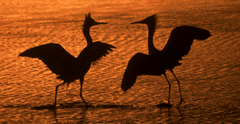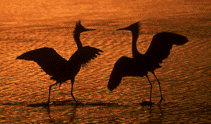Hope that all is well with you. All
here at BIRDS AS ART (at Bosque Del Apache NWR in NM) is A-OK.
Photography at Bosque continues to be spectacular. Though this is my sixth
year here, I have shot more film in ten days than I ever in ten days any time
any where, including the Pribilofs, Churchill, even Kenya.
I received many e-mails regarding the Canon 600 IS
lens. Here is one that is from Chris Gomersall, a Nikon shooter
from the UK. My responses are included.
Hi Chris,
Re your recent e-mail:
"Comments from a pro Nikon user on this side of "the pond," sadly not
enjoying the benefits of manufacturer's sponsorship:"
Now don't be bitter; as you well know, Nikon sponsors very, very few
photographers on any side of any pond.
"If Nikon suddenly launched an IS 500mm or 600mm, I wouldn't be in any
hurry to trade in my 500mm AF-S."
If you photograph birds, then you would be making a big mistake.
Why? If someone offered you a lens of twice the focal length that
weighed less (the 600 IS) or about the same (the 500 f/4 IS) as your present
long telephoto, and you turned them down, then you'd be quite foolish.
And that is just what Canon has done with its new IS series lenses. I
now shoot routinely at the 1200mm focal length. And the results are
consistently sharp.
"OK, IS could help you with straight bird portraits that you'd
normally want to shoot at 1/250sec. or thereabouts. But there is less and less
of a market for these comparatively dull shots."
The misconception that only action sells is a huge one; far more than
half of the images that I sell are static portraits, static but well
done. Just this morning at Bosque Del Apache NWR in southern New Mexico,
I made vertical front-end portraits of a Curve-billed Thrasher with the
600mm/2X TC combination. The up- close and personal rendition of its
drop-dead bright yellow eye that the 1200mm setup allowed will assure that
these images will be anything but boring.
"and more and more demand for bird action photographs - both 1/1000s and
1/15s seem to be acceptable for this kind of work, where you either want to
freeze the subject action or show it "creatively." I can do that quite
adequately already, thanks!
No thanks on many grounds. First, the IS 2 mode (for panning) allows
photographers to produce far more pleasing images when seeking to achieve
blurred motion at extremely slow shutter speeds. Without IS, many of these
images are just jumbles of color. With IS 2 technology, the subject is
almost always far more recognizable and well defined, and the blur more
pleasing. And all this against a pleasingly blurred and streaked
background. Second, here at Bosque, I have been experimenting
with flight shooting with the 600mm IS/2X TC combination. The first images
that I got back from the lab were of Sandhill Cranes in flight and
landing. I was fully prepared to find that the images were less than tack
sharp (as I was really pushing the envelope here). When I saw the slides,
I was stunned. Virtually every image was tack sharp with the bird's
eye and even the pupil sharply rendered! These cranes were more than a hundred
yards away....... I am now making photographs that were simply not
possible before. Third, because the new Canon IS lenses are the fastest
focusing super telephotos in the world, initial focus acquisition with the
1200mm setup is remarkably fast. D. Robert Franz, professional furry
creature photographer from this side of the pond, tried this setup here in NM
for a bit and felt that the 600IS/2X TC combination focused faster than his old
600mm f/4 lens alone (both with EOS 3 bodies of course). While I do not
believe that this is true, focus acquisition when using the 1200mm combo is
indeed very fast. (Note: for flight shooting with the 1200mm combo I
have been using IS 1 mode with great success. The reason that I tried IS 1
mode in this situation is that with this extremely long focal length a
bird's speed relative to my position is extremely slow. Go figure.)
"We
Nikon users seem to be in the minority to Canon EOS in the UK these days,
I hope that all of you UK Nikon users are using F-5s, else there is NO
reason to be using Nikon at all.
but many of us happily use our 500mm and 600mm Nikkors with 1.4x and
2x teleconverters, sometimes even stacked. And they still autofocus - have done
so for years!"
A small advantage (initial focus acquisition is surely slow at best with
stacked multipliers) to Nikon here, as with stacked multipliers neither the
Canon 500 or 600 IS will autofocus.
"You have to file down a lug on the lens mount to enable this
though."
Yes, I know that. It is stated in my book, "The Art of Bird Photography."
"Hope your system performs well for you at Bosque,
Thanks; it has, beyond my wildest dreams.
and that you don't find battery drain a problem."
Yes, IS technology does cut down on battery life. I am getting about
20 rolls out of each fully charged Nicad.
For those who do not know me and think that my response to the new 600 IS
lens is pure Canon-hype, please note that I have been, and always will be
the first to criticize Canon, and that I have been more than willing to praise
Nikon when they come up with new technologies that I believe make
photographer's lives easier (RGB metering for one.)
Chris, I know that good photographers using Nikon telephoto lenses can make
great images; they have been doing so for decades. And please realize
that this is not a Canon/Nikon which-is-better issue. It is
a simple fact that the new Image Stabilizer lenses will allow
bird photographers (and others, I'm sure), to make images that simply could
not and cannot be made with non-IS telephoto lenses.
Best and great picture making,
Arthur Morris


